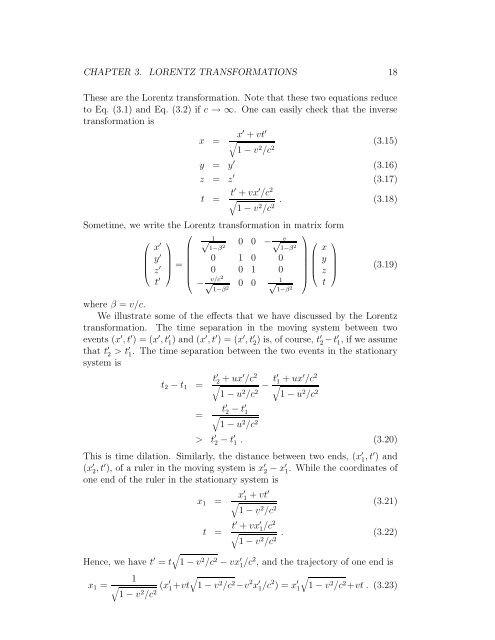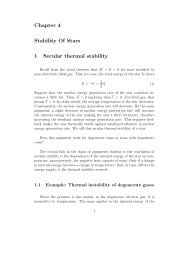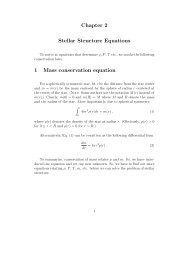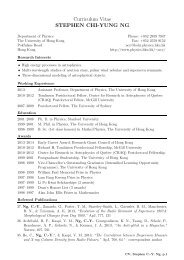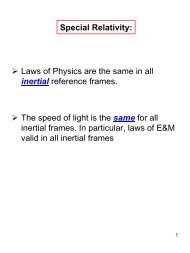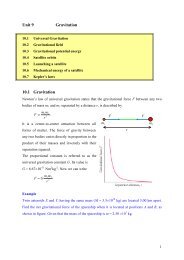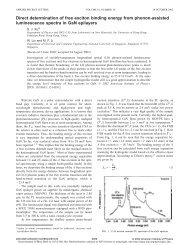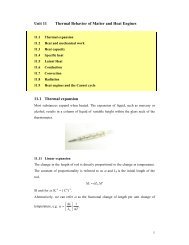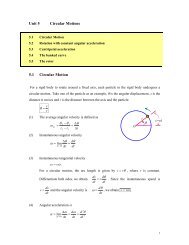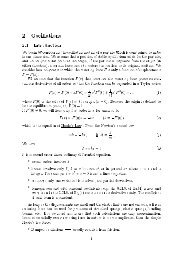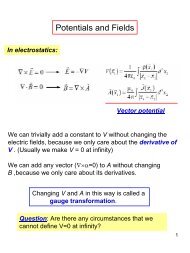here - Department of Physics, HKU
here - Department of Physics, HKU
here - Department of Physics, HKU
Create successful ePaper yourself
Turn your PDF publications into a flip-book with our unique Google optimized e-Paper software.
CHAPTER 3. LORENTZ TRANSFORMATIONS 18<br />
These are the Lorentz transformation. Note that these two equations reduce<br />
to Eq. (3.1) and Eq. (3.2) if c → ∞. One can easily check that the inverse<br />
transformation is<br />
x ′ + vt ′<br />
x =<br />
(3.15)<br />
√1 − v 2 /c 2<br />
y = y ′ (3.16)<br />
z = z ′ (3.17)<br />
t = t′ + vx ′ /c<br />
√1 2<br />
− v 2 /c . 2 (3.18)<br />
Sometime, we write the Lorentz transformation in matrix form<br />
⎛<br />
⎛<br />
x ′ ⎞ √ 1 0 0 − v ⎞<br />
√ ⎛ ⎞<br />
1−β y ′<br />
2 1−β 2<br />
x<br />
⎜<br />
⎝ z ′ ⎟<br />
⎠ = 0 1 0 0<br />
y<br />
⎜ 0 0 1 0<br />
⎜ ⎟<br />
⎟ ⎝ z ⎠<br />
t ′ ⎝<br />
1 ⎠<br />
0 0 √ t<br />
√1−β 2<br />
− v/c2<br />
1−β 2<br />
(3.19)<br />
w<strong>here</strong> β = v/c.<br />
We illustrate some <strong>of</strong> the effects that we have discussed by the Lorentz<br />
transformation. The time separation in the moving system between two<br />
events (x ′ , t ′ ) = (x ′ , t ′ 1) and (x ′ , t ′ ) = (x ′ , t ′ 2) is, <strong>of</strong> course, t ′ 2 −t ′ 1, if we assume<br />
that t ′ 2 > t′ 1 . The time separation between the two events in the stationary<br />
system is<br />
t 2 − t 1 = t′ 2 + ux ′ /c 2<br />
√<br />
1 − u 2 /c − t′ 1 + ux ′ /c 2<br />
√<br />
2 1 − u 2 /c 2<br />
=<br />
t ′ 2 − t′ 1<br />
√<br />
1 − u 2 /c 2<br />
> t ′ 2 − t′ 1 . (3.20)<br />
This is time dilation. Similarly, the distance between two ends, (x ′ 1 , t′ ) and<br />
(x ′ 2 , t′ ), <strong>of</strong> a ruler in the moving system is x ′ 2 − x′ 1 . While the coordinates <strong>of</strong><br />
one end <strong>of</strong> the ruler in the stationary system is<br />
x 1 =<br />
x ′ 1 + vt′ √1 − v 2 /c 2 (3.21)<br />
t = t′ + vx ′ 1 /c2 √1 − v 2 /c 2 . (3.22)<br />
√<br />
Hence, we have t ′ = t 1 − v 2 /c 2 − vx ′ 1 /c2 , and the trajectory <strong>of</strong> one end is<br />
x 1 =<br />
1 √<br />
√<br />
√1 − v 2 /c 2 (x′ 1+vt 1 − v 2 /c 2 −v 2 x ′ 1/c 2 ) = x ′ 1 1 − v 2 /c 2 +vt . (3.23)


